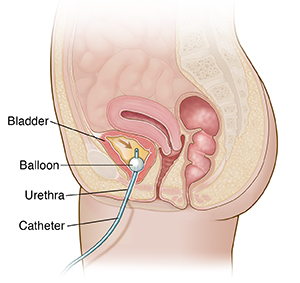Urinary Retention (Female)
Urinary retention means you are having trouble urinating. In some cases you may not be able to pass any urine at all. This condition occurs even though your bladder is full.
Causes
For girls and women, the most common cause of urinary retention is a bladder infection. Certain medicines can also cause this problem. So can changes in the body, such as uterine prolapse and severe constipation.
Symptoms
Some people have no symptoms. For others, common symptoms include:
-
Bladder or lower-belly pain or fullness
-
Belly swelling
-
Nausea or vomiting
-
Back pain
-
Frequent urination
-
Feeling that the bladder is still full after urinating
-
Not being able to control the release of urine (incontinence)
Treatment
This condition is treated by putting a tube (catheter) into the bladder to drain the urine. This gives relief right away. The catheter may need to stay in place for a few days. The catheter has a balloon on the tip. This is inflated after the catheter is put in the bladder. This prevents the catheter from falling out.

Home care
-
If a catheter was left in place, it's important to keep bacteria from getting into the collection bag. Don't disconnect the catheter from the collection bag.
-
Use a leg band to secure the drainage tube so it does not pull on the catheter. Drain the collection bag when it becomes full, using the drain spout at the bottom of the bag.
Follow-up care
Follow up with your healthcare provider, or as advised.
If a catheter was left in place, it can often be removed in 3 to 7 days. Some conditions require that the catheter stays in longer. Your provider will tell you when to come back to have the catheter removed.
When to get medical advice
Call your healthcare provider right away if any of these occur:
-
Fever of 100.4ºF (38ºC) or higher, or as directed by your provider
-
Bladder or lower-belly pain or fullness
-
Belly swelling, nausea, vomiting, or back pain
-
Blood or urine leakage around the catheter
-
Bloody urine coming from the catheter (if a new symptom)
-
Weakness, dizziness, or fainting
-
Confusion or change in normal level of alertness
-
If you have a catheter, see your provider if the catheter:
Online Medical Reviewer:
Donna Freeborn PhD CNM FNP
Online Medical Reviewer:
Marc Greenstein MD
Online Medical Reviewer:
Raymond Kent Turley BSN MSN RN
Date Last Reviewed:
11/1/2022
© 2000-2025 The StayWell Company, LLC. All rights reserved. This information is not intended as a substitute for professional medical care. Always follow your healthcare professional's instructions.